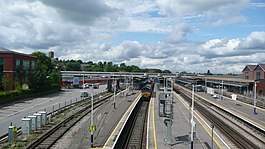Guildford railway station (Surrey)
| Guildford |
|
|---|---|

Guildford Station, looking north
(from Farnham Road road bridge) |
|
| Location | |
| Place | Guildford |
| Local authority | Borough of Guildford |
| Grid reference | SU991496 |
| Operations | |
| Station code | GLD |
| Managed by | South West Trains |
| Number of platforms | 8 (7 in use) |
| DfT category | B |
| Live arrivals/departures, station information and onward connections from National Rail Enquiries |
|
| Annual rail passenger usage* | |
| 2011/12 |
|
| 2012/13 |
|
| 2013/14 |
|
| 2014/15 |
|
| 2015/16 |
|
| History | |
| Key dates | Opened 5 May 1845 |
| National Rail – UK railway stations | |
| * Annual estimated passenger usage based on sales of tickets in stated financial year(s) which end or originate at Guildford from Office of Rail and Road statistics. Methodology may vary year on year. | |
|
|
|
Guildford railway station is at one of three main railway junctions on the Portsmouth Direct Line and serves the town of Guildford in Surrey, England. It is 30.3 miles (48 km) from London Waterloo.
It provides an interchange station for two other railway lines: the North Downs Line northwards towards Reading, which has a connection to Aldershot; the same line eastwards to Redhill; and the New Guildford Line, the alternative route to Waterloo, via Cobham or Epsom.
Guildford station is the larger, more frequently and more diversely served of the two stations in Guildford town centre, the other being London Road (Guildford), on the New Guildford Line however its London services operator is the same.
The station was opened by the London and South Western Railway (LSWR) on 5 May 1845, but was substantially enlarged and rebuilt in 1880.
The Reading, Guildford and Reigate Railway opened its services on 4 July 1849, and was operated by the South Eastern Railway. LSWR services to Farnham via Tongham began on 8 October 1849 and the New Guildford Line to Leatherhead and Epsom Downs on 2 February 1885. On the latter line is the other Guildford station: London Road: the line to it describes a curve around the town on an embankment, crossing the River Wey by a high bridge.
...
Wikipedia
